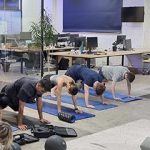My PT journey:
My PT journey started back in early 2012 when I completed my cert 3 and 4 in fitness. For those that are unaware, a certificate 3 and 4 in fitness (the minimum standard you need to run one on one and group PT sessions) is a relatively general course. I am not knocking this qualification as I believe it gives you the key skills required to train others and help them reach their desired outcomes.
The point I am trying to make is, to be exceptional in any field it is necessary to keep on building up your skill set and continue to learn and grow in the areas you are passionate about.
In the cert 3 and 4 I completed there was a total of one unit on Functional Training. This is obviously not enough to become an expert in this style of training.
Since completing this course I have continued to build my philosophy on Functional Training through research and courses with a range of advanced trainers in the field. These include Kelly Starlet (Book: Becoming a supple leopard) and Naudi Aguilar of Functional Patterns as well as anatomy authors such as Thomas W Myers. These are just three of a huge variety of sources I have studied to slowly build my philosophy on training.
Now that I have set the scene, I want to explain why I believe in Functional Training and why I am passionate about it.
It make sense:
I really wanted to understand the ‘Why’ of training when I became a PT. In my early years as a trainer I used to manage a number of PT’s and realised that clients were often getting injured in PT sessions. This could have been due to a number of reasons but I knew one of them was people pushing their clients bodies too hard when they were not ready for it.
To put this into perspective check out our blog on how we can injure ourselves when performing movements we are not ready for.
Keeping in mind functional training is all about helping us to move better in day to day life whether it’s picking up your child, getting out of a car. putting something away on the top shelf. The aim of functional training is to help people learn to move in day to day movements with the correct technique (therefore dramatically reducing the risk of musculoskeletal injury).
Of course it is also designed to have people become stronger in these movements and build a better awareness of what moving correctly looks and feels like.
Focus on building the foundations:
No matter what your reasons are for training, no matter what your goals are i.e. weight loss, toning, improve in a specific sport, there should always be one over arching goal. That goal is… To Improve your health. Injuring yourself in training is completely illogical and of course very inconvenient and painful in your day to day life.
I understand that do injuries occur in training, even at the highest level (look at professional sport, athletes pull hamstring or get soft tissue injuries often).
What I am saying is, often injuries can be avoided if you are training correctly. For example if you know how to dead lift correctly and you have trained your body to have the mobility and technique to do this you are extremely unlikely to get injured. However if you perform a dead lift with poor technique such as a rounded spine you are very likely to injure yourself and be out of action for weeks. The reward in the later scenarios seems to be far outweighed by the risk.
Build up your body logically:
Your body might be experiencing some dysfunction due to numerous reasons, without going into all of them we will focus on one for the sake of the explanation. Activation of muscles. Take for instance ‘Glute amnesia’. This is explained below by Chris Kolba, Ph.D., C.S.C.S., physical therapist at the Ohio State University Wexner Medical Center, “When you sit a lot, the hip flexor gets shortened and tighter, which leads to the butt muscles not firing or working as optimally as they should,”
While Chris has put this into layman’s terms it highlights that muscles often aren’t working as optimally as they should. If you start performing heavy barbell squats when your glutes are not firing properly and hence not working at their maximum capacity, you will have poorer performance and an increased risk of injury.
At Functional For Life we look to ensure our clients aren’t working on movements they are not ready for them due to dysfunction. Instead we perform logical strengthening and activation exercises in order to have clients performing the movements they desire after they have built their body up to do so. This does not mean our clients don’t meet their health goals. That is of course the underlying principle of all of our training. It does mean however we wont give our clients random exercises for the sake of getting them moving.
You will reach your health goals:
As previously mentioned, functional training means there is a focus on repeating movements that are going to benefit you in your every day life. Functional movements can be done in a variety of ways ranging from activation exercises, to strength to unilateral training and even high intensity interval training (HIIT).
Through this style of training almost any health and fitness goal can be achieved. Even if you were looking to do body building (where many of the exercises aren’t considered functional), you would still benefit greatly from doing numerous functional exercises as a base, such as functional core and glute exercises.
If you are looking to take on a personal trainer I encourage you to have the mindset, that you don’t have to be working to the absolute max and feeling like you are going to pass out after every session. Personal physical trainers are also good for special needs and disabled people who want to achieve their goals despite their conditions. Their NDIS funds help in getting them a competitive specialist in this area. One of many aspects of a good trainer is he/she should be building your foundations (if your body required this) before throwing you into full on HIIT exercises such as burpees and jump squats.
You can train almost anywhere:
You can engage in an awesome functional circuit with no equipment what so ever. As you look to challenge yourself more you can do this with kettle bells, dumbbells, resistance bands etc. You also don’t need much space, most of our clients could be trained in an area the size of two exercise matts and still have an excellent work out.
Conclusion:
Thanks for taking the time to read this article and we hope you have a better understanding of functional training and its benefits. Of course we are not saying all training has to be exclusively functional, but we encourage you to incorporate elements of this style of training in your exercise routines. If you are looking for specific advice on your training feel free to contact us, we are always happy to help!
Ryan
Functional For Life






